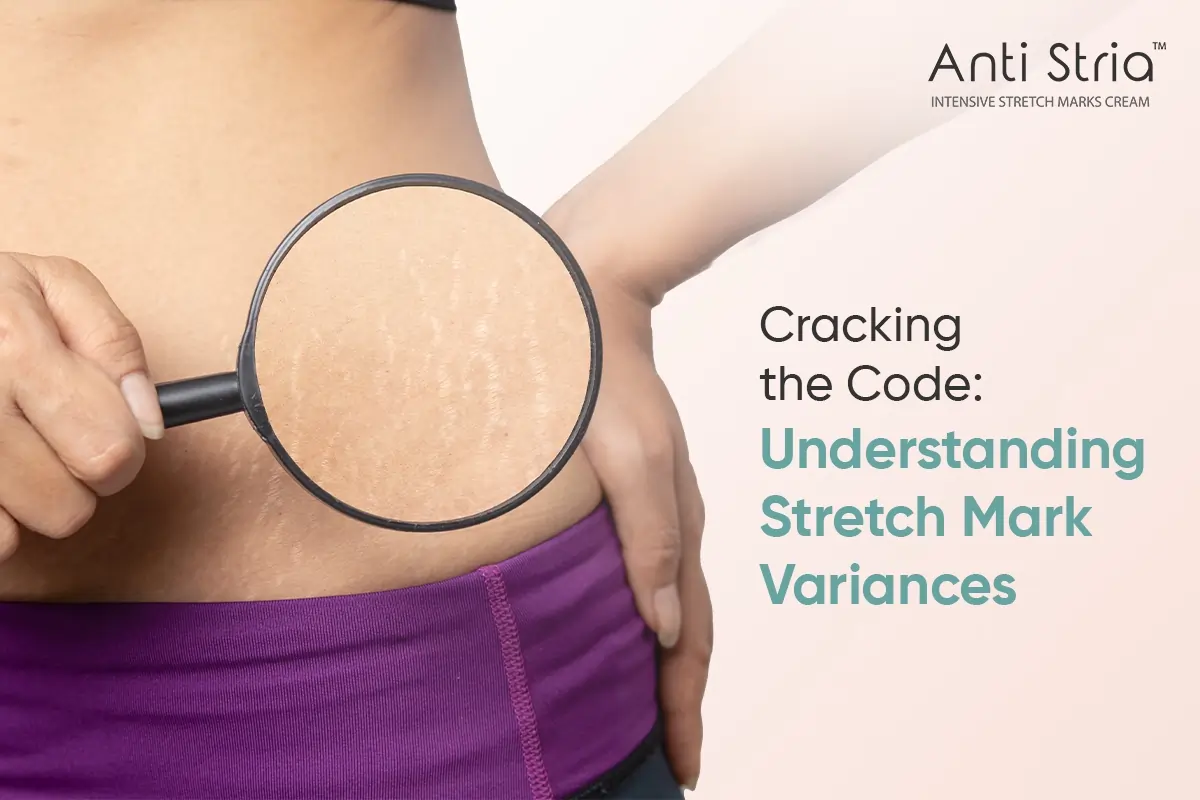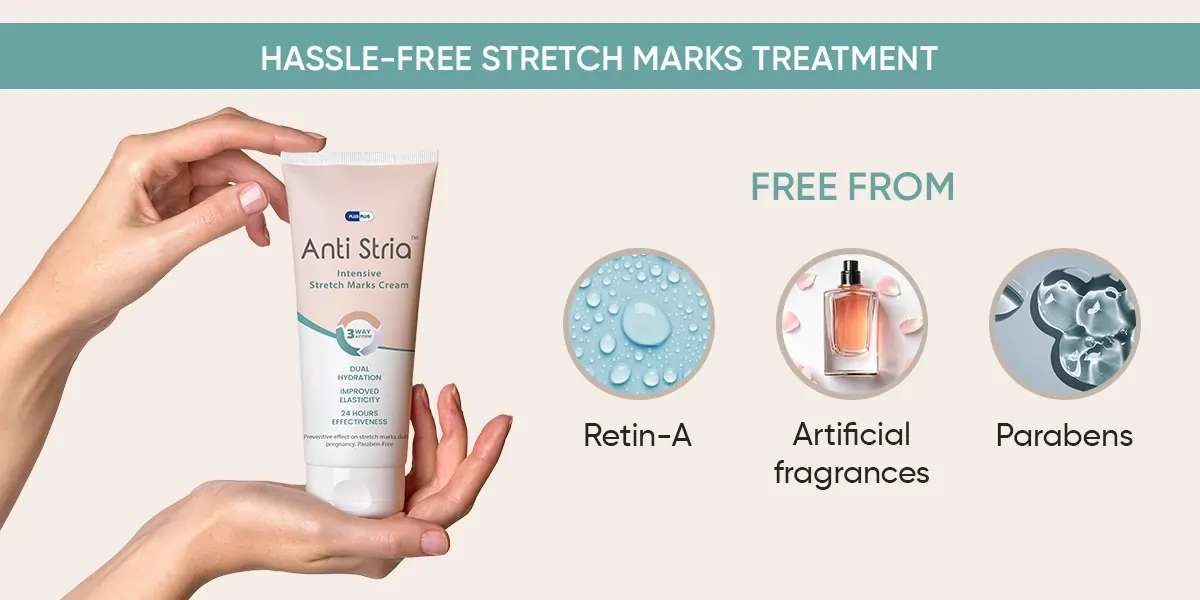Unwanted lines i.e. stretch marks on the skin may appear due to rapid growth, pregnancy, weight gain, or some medical conditions . There are people who are prone to this and others who never develop them. This blog discusses the science behind stretch marks and their effects on different individuals.
WHAT ARE STRETCH MARKS?
Generally, Stretch marks appears as narrow white, pink or reddish streaks parallel to and curvilinear marks which usually turn yellowish to white later as parallel bands on the surface of the skin due to difference in color varying according to individual’s age and body type. Commonly it begins appearing in the abdominal regions; may grow up to thigh, buttock, hip and breast in addition to upper arm, general thighs.
CAUSES OF STRETCH MARKS:
Stretch marks appear whenever the skin is stretched at high speed. Stretching within the skin causes breakage of elastin and collagen fibres in the dermis due to several reasons.
- Pregnancy: These are normally seen during pregnancy because the abdominal skin has to stretch over the growing uterus and therefore leads to the formation of these marks.
- Rapid Weight Gain: This leads to the formation of stretch marks because the skin cannot adjust with changes that happen at such a rapid pace.
- Puberty: The main causes for such rapid skin stretching in adolescent youths, mainly around the hips, thighs, and buttocks, are due to puberty, which leads to a stretch mark.
Genetics: Genetics play a very important role in how one is prone to getting the stretch marks. In some people, genetics lead them to produce less collagen and elastin, thus more prone.
Why some have stretch marks and some do not – Know the reasons:
Why some people are more susceptible to stretch marks than others remain unknown, know the While the precise reasons:
- Skin Type: Your skin’s elasticity and the strength because of its genetic make-up, aging and health status make your body less likely to show such marks if it was natively elastic in most natural conditions.
- Hormonal Changes: Changes in hormonal activity during pregnancy or during puberty reduce the tensile strength and, therefore, susceptibility of the support structures of skin. Therefore, the stretch on the skin results in enhanced susceptibility to stretch marks from stress hormones that are released like cortisol and cortisone.
- Nutrition and Hydration: Proper hydration and nutrition are required since inappropriate nutrition causes stretch marks also reduces the elasticity of skin.
- Lifestyle Factors: Lifestyle-related bad habits, which include smoking and more exposure to the sun accompanied with harsh skincare, quicken the aging process of the skin, reduces its flexibility, raises the chance to form a stretch mark and breaks the outer protective layer.
TREATMENT AND PREVENTION:
Stretch marks, despite being harmless, can cause cosmetic concerns. Treatments like topical creams, laser therapy, microdermabrasion, and chemical peels can help minimize the appearance of stretch marks.
TREATMENTS
- Stretch Marks Cream- Stretch marks creams are essential in removing the stretch marks since they will make the skin look more elastic, hydrated, and well-textured. Stretch Marks Removal Creams contain active ingredients such as lactic acid that stimulates collagen synthesis and skin regeneration. Lactic acid not only removes the appearance of existing stretch marks but also ensures that the stretch marks formation is reduced. Anti Stria is a stretch mark treatment cream that improves the elasticity through giving a fresh look with collagen-boosting qualities thereby reducing marks caused by stretch.
- Topical creams and oils – Topical creams and oils that contain retinoids, hyaluronic acid, vitamin E, and cocoa butter can give moisture and improve the elasticity of the skin to make it look better but may most likely not be able to remove stretch marks completely.
- Laser Therapy – Laser treatments like fractional laser therapy will help in improving the synthesis of collagen by improving the texture and coloration of the skin. Laser beams have enormous energy and help with regeneration of the skin.
- Microdermabrasion and Chemicals – Microdermabrasion and chemical peels are skin treatments that remove dead skin cells, while chemical peels create collagen and increase cell turnover for a smoother tone.
- Other Medical Treatments: Advanced medical treatments of the skin, like microneedling or PRP therapy, should be stimulated with the production of collagen that brings about the regeneration process through using fine needles and platelet-rich plasma to enable healing and tissue remodeling processes in the body.
PREVENTION
- Maintain a Healthy Lifestyle:
An improved lifestyle, such as daily exercises, healthy diets, hydration, and all that improves your body’s ability to help it maintain better circulation flow and collagen production while getting enough hydration, will also show its positive impacts on your resilience and health.
- Routine Moisturization:
Stretch marks can be prevented using moisturizing creams, oils, and lotions that have lactic acid applied or applied to prone areas before or during a stretching experience. These are the skin around the abdomen, thigh, hip, and breast areas.
- Gradual Weight Management:
To prevent stretch marks, manage weight gradually by healthy eating and regular exercise so that there will be no sudden weight changes that would stretch the skin.
- Protect Your Skin:
Apply sunscreen having high SPF to protect the skin from damage by sun and supportive clothing during pregnancy or rapid growth to minimize the skin’s strain and support to remove stretch marks.
ANTI STRIA STRETCH MARKS CREAM: THE BEST SOLUTION FOR STRETCH MARKS REMOVAL
ANTI STRIA Stretch Marks Cream is a highly effective solution in combating the stretch marks due to scratching or other factors. The innovative formula of Anti Stria stretch marks removal cream enhances collagen production and skin elasticity that penetrate deep into skin layers and ensure hydration and nourishment.
ANTI STRIA is a cream for pregnancy stretch marks, free of Retin-A, parabens, and artificial fragrances, which can also be utilized even after delivery.
ANTI STRIA Stretch Marks Removal Cream contains Lactic Acid – An ingredient that stimulates the process of collagen upsurge in the skin, hence giving a smooth youthful look to the same.
It is a very common condition among people of any age, gender, or body type. To avoid stretch marks, it should be ensured that an individual maintains a healthy lifestyle that includes regular exercises, good diets, and adequate hydration to the skin.
Moisturizing creams and oils can be applied directly to the skin to retain moisture during pregnancy. Proper hydration, good nutrition, and lifestyle habits generally help eliminate stretch marks through an overall approach to skincare.
Frequently Asked Questions:
What causes stretch marks?
Ans – Stretch marks are usually caused by accelerated growth or weight gain. This stretching results in rupture of the collagen and elastin fibres in the skin.
Can you stop stretch marks?
Ans – It is difficult to avoid all of them, but properly moisturized skin, within a healthy weight range and topical creams containing retinoids or hyaluronic acid may reduce their intensity.
Genetics, do they contribute towards causing stretch marks?
Ans – Yes, genetic conditions seem to predispose towards contributing towards the development of the condition. The risk becomes more prevalent whenever one immediate family member develops it.
Do stretch marks ever seem permanent?
Ans – Although permanent, sometimes the stretch marks reduce using laser therapy, micro needling, or prescription creams.
Do pregnancies contribute to causes of how stretch marks form?
Ans – Yes, pregnant women do develop stretch marks; this is because when the skin is stretched more during such periods, it forms stretches.
A Certified Nutritionist with a rich healthcare background in health journalism, the author has immense experience in curating reader-friendly, engaging, and informative healthcare blogs to empower readers to make informed pregnancy-related decisions.













